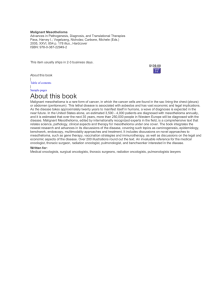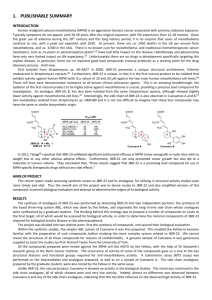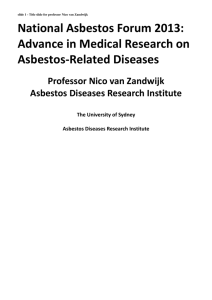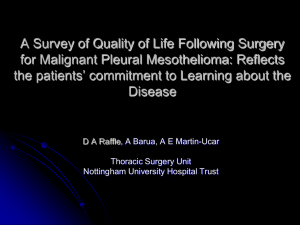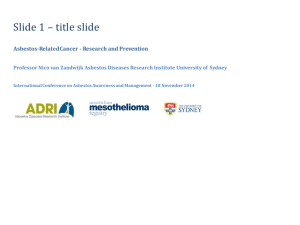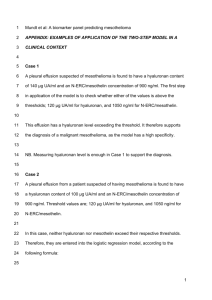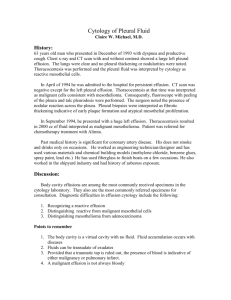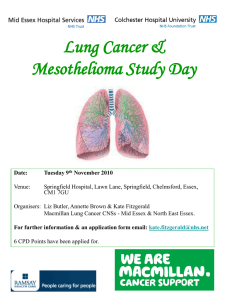Mesothelioma in Australia Incidence 1982 to 2009 Mortality 1997 to
advertisement
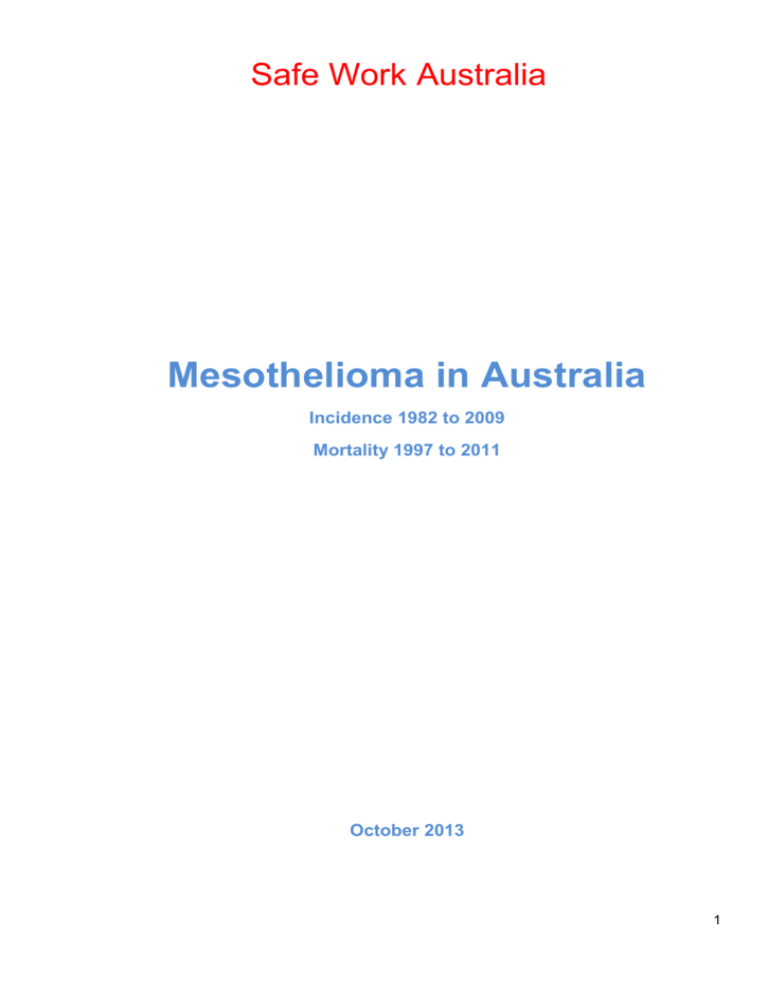
Safe Work Australia Mesothelioma in Australia Incidence 1982 to 2009 Mortality 1997 to 2011 October 2013 1 Acknowledgement Data on the number of new cases of mesothelioma in this report are collected by the National Cancer Statistics Clearing House, maintained by the Australian Institute of Health and Welfare (AIHW). Data on fatal cases of mesothelioma are collected in the National Mortality Database, made available to us by the AIHW. The authors, and not these agencies, are responsible for the use of the data in this report. The authors would like to thank the State Cancer Registries and the AIHW for allowing access to the data presented in this report. Disclaimer The information provided in this document can only assist you in the most general way. This document does not replace any statutory requirements under any relevant State and Territory legislation. Safe Work Australia is not liable for any loss resulting from any action taken or reliance made by you on the information or material contained on this document. Before relying on the material, users should carefully make their own assessment as to its accuracy, currency, completeness and relevance for their purposes, and should obtain any appropriate professional advice relevant to their particular circumstances. To the extent that the material on this document includes views or recommendations of third parties, such views or recommendations do not necessarily reflect the views of Safe Work Australia or indicate its commitment to a particular course of action. Creative Commons ISBN 978-1-74361-181-4 [Online pdf ] ISBN 978-1-74361-182-1 [Online doc ] With the exception of the Safe Work Australia logo, this report is licensed by Safe Work Australia under a Creative Commons 3.0 Australia Licence. To view a copy of this licence, visit http://creativecommons.org/licenses/by/3.0/au/deed.en In essence, you are free to copy, communicate and adapt the work, as long as you attribute the work to Safe Work Australia and abide by the other licensing terms. The report should be attributed as the Mesothelioma in Australia: Incidence 1982 to 2009, Mortality 1997 to 2011. Enquiries regarding the licence and any use of the report are welcome at: Copyright Officer Communications, IT and Knowledge Management Safe Work Australia GPO Box 641 Canberra ACT 2601 Email: mailto:copyrightrequests@swa.gov.au 2 Contents Report summary 4 Introduction 5 Asbestos production, use and control in Australia 5 Mesothelioma projections 6 The new Australian Mesothelioma Registry 6 Incidence of mesothelioma 7 New cases diagnosed in 2009 7 Trends over time, 1982 to 2009 8 National data 8 State and Territory data 11 Deaths due to mesothelioma 14 Deaths in 2011 14 Trends over time, 1997 to 2011 15 National data 15 State and Territory data 16 References 18 Useful links 18 3 Report summary Data on the number of new cases of mesothelioma are collected nationally by the Australian Institute of Health and Welfare (AIHW) in the National Cancer Statistics Clearing House, via the state and territory Cancer Registries. Information on deaths from mesothelioma is also collected by the AIHW as part of the National Mortality Database. Data are available from 1982 to 2009 for the number of new cases, and from 1997 to 2011 for the number of deaths. New cases diagnosed > In 2009 there were 666 new cases of mesothelioma diagnosed in Australia. The total number of new cases of mesothelioma diagnosed has risen steadily in most years since 1982, when national data first became available, and reached a peak of 653 new cases in 2003. The number of new cases then decreased to 591 in 2006 which initially suggested a decreasing trend. However, the number of diagnoses reported in 2007 reached a new peak of 675 cases. This increase between 2006 and 2007 was mainly due to an increase in diagnoses for men (from 487 to 566 new cases respectively). > In 2009, the age-standardised incidence rate of new cases of mesothelioma was 2.8 per 100 000 population. This rate has increased over time, from 1.2 cases in 1982 to a peak of 3.2 in 2003. In 2009, the highest age-specific incidence rate of new cases occurred among men aged 80–84 years: 44 cases per 100 000 population aged 80–84 years. Deaths due to mesothelioma > In 2011, 606 deaths were attributed to mesothelioma. Data on the number of deaths due to mesothelioma are available for the years 1997 to 2011. Reflecting the increase in incidence of new cases diagnosed, the overall number of deaths resulting from mesothelioma generally increased over the period between 1997 and 2011 and reached a peak of 634 deaths in 2010. > In 2011, the age-standardised mortality rate from mesothelioma was 2.5 deaths per 100 000 population. The overall age-standardised mortality rate has remained relatively stable over the fifteen years for which data are available, ranging between a minimum of 2.1 deaths per 100 000 population in 1999 and a maximum of 2.7 in 2001. 4 Introduction Mesothelioma is a fatal cancer that typically occurs 20 to 40 years after exposure to asbestos — although exposure does not necessarily result in the disease. All new cases of mesothelioma are notified to state and territory Cancer Registries, as mesothelioma is a notifiable disease. These data are collected nationally by the Australian Institute of Health and Welfare (AIHW) in the National Cancer Statistics Clearing House (NCSCH). Information on deaths from mesothelioma is also collected by the AIHW as part of the National Mortality Database. The AIHW publishes cancer data in spread sheets on its website. This report uses the mesothelioma data, and additional data supplied by the state and territory cancer registries to the AIHW, to report on the incidence of new cases and deaths from mesothelioma by both age and sex. In addition, trends over time are shown for the period 1982 to 2009 for the number of new cases, and from 1997 to 2011 for the number of deaths. Mesothelioma of the pleura (a cancer affecting the protective lining of the lung and chest cavity) is the most common form of mesothelioma diagnosed in Australia: involving approximately 93% of cases since 1982. Mesothelioma of the peritoneum (a cancer affecting the abdominal lining) is a much less common diagnosis, accounting for approximately 6% of cases since 1982. The figures presented in this publication include all forms of mesothelioma. Asbestos production, use and control in Australia In Australia, more chrysotile (white asbestos) than amphibole (blue and brown) asbestos was mined until 1939. New South Wales, the first state to mine asbestos, produced the largest tonnages of chrysotile (until 1983) as well as smaller quantities of amphibole (until 1949). With the commencement of mining in Wittenoom in Western Australia in 1937, crocidolite (blue asbestos) dominated production until final closure of the mine in 1966. The main sources of raw asbestos imports were from Canada (chrysotile) and South Africa (crocidolite and amosite (brown asbestos)). Consumption peaked in about 1975 at approximately 70 000 tonnes per year. In addition to imports of asbestos fibre, Australia also imported many manufactured asbestos products, including asbestos containing cement articles, yarn, cord and fabric, joint and millboard, friction materials and gaskets. The main sources of supply were the United Kingdom (UK), United States of America (USA), Federal Republic of Germany and Japan. With the closing of the crocidolite mine at Wittenoom, Australian asbestos production and exports declined. Imports of chrysotile also started to decline. In Australia, over 60% of all production and 90% of all consumption of asbestos fibre was used in the asbestos cement manufacturing industry. From about 1940 to the late 1960s all three types of asbestos were used in this industry. The use of crocidolite began being phased out from 1967. Amosite was used until the mid 1980s. Much of the industry output remains in service today in the form of “fibro” houses and water and sewerage piping. By 1954, Australia was number four in the Western world in gross consumption of asbestos cement products, after the USA, UK and France: and clearly first on a per capita basis. After World War II to 1954, 70 000 asbestos cement houses were built in the state of New South Wales alone (52% of all houses built). Until the 1960s, 25% of all new housing in Australia was clad in asbestos cement. Exposures to asbestos in the past were very high in some industries and occupations: as much as 25 million particles per cubic foot (150 fibres/ml) in asbestos pulverisors and disintegrators in the asbestos cement industry, and up to 600 fibres/ml among baggers at Wittenoom. The use of asbestos products has been regulated since the late 1970s. A series of regulations adopted in the late 1970s and early 1980s by the various states imposed exposure limits of 0.1 fibres/ml for crocidolite and amosite, and 5 0.1-1.0 fibres/ml for chrysotile. In July 2003, a revised national exposure standard for chrysotile asbestos of 0.1 fibres/ml was declared by the National Occupational Health and Safety Commission (NOHSC). The prohibition of all forms of asbestos was adopted simultaneously under regulations in each Australian jurisdiction and Australian Customs on 31 December 2003. A new national Model Code of Practice, How to Manage and Control Asbestos in the Workplace, December 2011, is available as an electronic publication on the Safe Work Australia web site. This Code of Practice provides practical guidance for persons conducting a business or undertaking on how to manage risks associated with asbestos and asbestos containing material at the workplace and thereby minimise the incidence of asbestos-related diseases such as mesothelioma, asbestosis and lung cancer. Mesothelioma Projections Due to the long latency between exposure to asbestos and diagnosis of mesothelioma, typically between 20 and 40 years, it is expected that the incidence of mesothelioma will not peak until after 2013. Clements et al. (2007a) predict that the number of new cases in Australia will peak in 2017. In another study, Clements et al. (2007b) used two different models to project the incidence of mesothelioma in men in New South Wales. Using an age/birth cohort model, they predicted that the number of new cases would peak in 2021 and using a model based on potential exposure to asbestos in terms of age and calendar year, they predicted the peak would occur in 2014. The new Australian Mesothelioma Registry In February 2010, Safe Work Australia initiated and funded the establishment of a new Mesothelioma Registry (www.mesothelioma-australia.com). The registry is currently co-funded by Safe Work Australia and Comcare and administered by the Cancer Institute of New South Wales in association with the Monash Centre for Occupational & Environmental Health. Besides receiving notifications of new diagnosis of mesothelioma from all Australian cancer registries, consenting patients are asked about their residential, occupational and environmental history of exposure to asbestos. The Registry management committee includes some of the leading experts in asbestosrelated disease in Australia. The aims of the Australian Mesothelioma Registry are to: better understand the exact relationship between asbestos exposure and mesothelioma better understand the nature and levels of asbestos exposure that can result in mesothelioma identify the groups of workers exposed to potentially dangerous levels of asbestos and to prevent that exposure assist the development of policies to best deal with the asbestos still present in our environment (mainly our built environment) provide information to assist researchers in undertaking investigations with the aim of preventing mesothelioma in the future, and identify other potential exposures that may cause mesothelioma. The second annual report of the Australian Mesothelioma Registry was released on the website in September 2013. It provides information on diagnoses and deaths for the years 2011 and 2012. 6 Incidence of mesothelioma New cases diagnosed in 2009 All cases of cancer in Australia are notifiable by legislation to state and territory cancer registries. These registries report to the NCSCH which is operated by the AIHW under the supervision of the Australasian Association of Cancer Registries (AACR). National data on mesothelioma are available from 1982. National data presented in this report were provided by the AIHW. State and territory data were provided by the relevant registry through the AIHW. Incidence in a calendar year is defined as the number of new cases of mesothelioma diagnosed in an Australian state or territory in that year. In 2009, there were 666 people diagnosed with mesothelioma in Australia. Of these new cases about four out of every five cases (81%) were men. Figure 1 New cases of mesothelioma: by age and sex, 2009 110 Males Females 100 Number of new cases 90 80 70 60 50 40 30 20 10 0 Age group (years) Figure 1 shows the distribution by age and sex of patients diagnosed with mesothelioma in 2009. There were 540 men diagnosed with mesothelioma (see Table 1). These men were predominately of older age: 420 (78%) were aged 65 years or more. There were two men in their late thirties diagnosed but no males younger. There were 126 women diagnosed with mesothelioma in 2009. Similarly to males, these women were predominately of older age: 90 (71%) were aged 65 years or more. There was one women aged in her late twenties diagnosed but none younger. 7 Figure 2 New cases of mesothelioma: age-specific incidence rate by sex, 2009 New cases per 100 000 population 50 Males 45 40 35 30 25 20 15 Females 10 5 0 Age group (years) Figure 2 shows the age-specific incidence rates (new cases per 100 000 population of that age) for the year 2009. For men, the incidence rate increased consistently and considerably with age: reaching a maximum of 44 new cases per 100 000 males among men aged 80–84 years. For women, a similar pattern was observed. The maximum rate for women occurred among those aged 85 years and over: 8 new cases per 100 000 females. Trends over time — 1982 to 2009 National data Figure 3 and Table 1 show that the total number of new cases of mesothelioma diagnosed has risen steadily in most years since 1982, when national data first became available, and reached a peak of 653 new cases in 2003. The number of new cases then decreased to 591 in 2006 which initially suggested a decreasing trend. However, the number of diagnoses reported in 2007 reached a new peak of 675 cases. This increase between 2006 and 2007 was mainly due to an increase in diagnoses for men (from 487 to 566 new cases respectively). The figure for 2009 is only slightly lower than the 2007 peak at 666 new cases. Figure 3 clearly shows that the large majority of new cases in any year involve males. However, the proportion of new diagnoses for females increased slightly over the collection period. Over the five-year period 1982 to 1986 females represented on average 12% of all new cases, whereas over the period 2005 to 2009 the average was 18%. 8 Figure 3 New cases of mesothelioma: year of diagnosis by sex, 1982 to 2009 700 Persons Number of new cases 600 Males 500 400 300 200 Females 100 0 Year of diagnosis Table 1 New cases of mesothelioma: year of diagnosis by sex, 1982 to 2009 Year Males Females Persons 1982 134 22 156 1983 131 15 146 1984 149 17 166 1985 178 24 202 1986 195 30 225 1987 174 29 203 1988 246 31 277 1989 229 40 269 1990 257 34 291 1991 260 47 307 1992 287 39 326 1993 318 51 369 1994 373 47 420 1995 335 59 394 1996 362 53 415 1997 393 75 468 1998 412 61 473 1999 401 76 477 2000 403 77 480 2001 468 107 575 2002 455 108 563 2003 541 112 653 2004 512 93 605 2005 499 113 612 2006 487 104 591 2007 566 109 675 2008 547 116 663 2009 540 126 666 9 Figures 4 and 5 show age-specific incidence rates for selected age groups for men and women respectively. The graphs show the incidence rates in the two oldest age groups generally increased markedly over the period for both men and women. Since 2003, the incidence rate among men aged 80 years and over declined from a peak of 50 new cases per 100 000 population in 2003 to 38 in 2006, before increasing again in 2007 to 49. The rate has since declined slightly to 42 new cases per 100 000 population in 2009. Similarly, among men aged 65–79 years the incidence rate increased between 2006 and 2007 and then declined slightly. Figure 4 New cases of mesothelioma: age-specific incidence rates for males, 1982 to 2009 New cases per 100 000 population 50 Males aged 80 years and over 40 Males aged 65–79 30 20 Males aged 50–64 10 Males aged 35–49 0 Year of diagnosis Figure 5 New cases of mesothelioma: age-specific incidence rates for females, 1982 to 2009 10 New cases per 100 000 population Females aged 80 years and over 8 6 4 Females aged 65–79 Females aged 50–64 2 Females aged 35–49 0 Year of diagnosis Since 2002, the incidence rate among women aged 80 years and over declined overall from 8.5 to 4.7 new cases per 100 000 population in 2007. In 2009 the rate returned to 8 new cases per 100 000 population (Figure 5). However, this pattern should be interpreted with caution as the rates are quite volatile due to the relatively small number of women diagnosed. 10 Age-standardisation is a method of adjusting the crude incidence rate to eliminate the effect of differences in population age structures when comparing crude rates for different periods of time. By applying the observed age-specific death rates in each year to a standard population, the expected number of deaths can be calculated and a more comparable age-standardised rate can be calculated for each year. Figure 6 shows the age-standardised incidence of new cases of mesothelioma (per 100 000 population) over the period 1982 to 2009. The overall incidence rate increased from a minimum of 1.1 new cases per 100 000 population in 1983 to a maximum of 3.2 in 2003. Since that date, the rate declined to 2.7 in 2006, increased again in 2007 to 3.0, and then fell again slightly to 2.8 in 2009. Figure 6 New cases of mesothelioma: age-standardised incidence rate by sex, 1982 to 2009 New cases per 100 000 population 6 Males 5 4 Persons 3 2 Females 1 0 Year of diagnosis The age-standardised incidence rate of new cases of mesothelioma for men was considerably higher than the rate for women in all years. The male rate ranged between a minimum of 2.1 new cases per 100 000 males in 1983 to a maximum of 5.9 in 2003. In 2009 there were 5 new cases per 100 000 males. The age-standardised incidence rate for women over the period ranged between 0.2 new cases per 100 000 females in 1983 and at or near 1 new cases per 100 000 females since 2005. Because asbestos exposure in the workplace and the general environment has now been greatly reduced, the incidence of new cases of mesothelioma in the population is expected to decline. However, because of the long latency between exposure to asbestos and diagnosis of mesothelioma (20 to 40 years) it is expected that the incidence of mesothelioma will not peak until sometime between 2014 and 2021, depending on the projection methodology. Further details can be found in the Introduction, under Mesothelioma projections — p.6. State and Territory data Figure 7 shows the five-year rolling average number of new cases of mesothelioma occurring in each state and territory over the time period 1982–1986 to 2005–2009: the period for which data are available for all states and territories. Five-year rolling averages are used to smooth random annual variations and preserve confidentiality in the smaller states and territories. Further detailed data by sex for each state and territory can be found in Table 2. The five-year rolling average number of new cases of mesothelioma in each state and territory generally reflects population distribution. The more populous states, New South Wales, Victoria and Queensland, reported the largest number of new 11 cases: respectively averaging 216, 140 and 125 cases a year over the five-year period 2005–09. These three states have also experienced relatively consistent and similar rates of increase in the number of cases of mesothelioma diagnosed over the period 1982–86 to 2005–09. The number of new cases diagnosed in Western Australia increased at a similar rate up until the mid-90s, and then the rate of increase reduced. In South Australia and Tasmania the rate of increase in the number of new cases since the early 90s was not as great as in other jurisdictions and both states show a recent decline in the five-year averages. Figure 7 New cases of mesothelioma: five-year rolling average number of cases by state or territory(a), 1982–1986 to 2005–2009 250 Average number of new cases NSW 200 150 Vic Qld 100 WA SA 50 Tas 0 Year of diagnosis (a) Because the number of mesothelioma cases in the ACT and the NT are relatively low, they cannot be plotted clearly at this scale. These numbers can be found in Table 2, p.13. 12 Table 2 New cases of mesothelioma: five-year rolling average number by state or territory by sex, 1986–1990 to 2005–2009 1986–90 1987–91 1988–92 1989–93 1990–94 1991–95 1992–96 1993–97 1994–98 1995–99 1996–00 1997–01 1998–02 1999–03 2000–04 2001–05 2002–06 2003–07 2004–08 2005-09 NSW Vic Qld WA SA Tas ACT NT Aust.total M 80 85 92 97 110 116 123 127 132 131 134 139 141 150 156 163 167 175 175 F 12 12 13 14 14 16 17 19 21 23 24 28 31 34 34 37 38 36 35 178 38 T 92 97 105 110 124 131 140 147 153 154 158 167 172 184 190 200 205 211 211 216 M 42 44 51 56 61 64 73 77 83 82 85 89 90 98 106 109 106 114 112 114 F 6 7 8 9 11 13 14 17 17 18 19 18 20 22 23 24 24 24 25 26 T 48 52 59 65 72 78 86 94 100 100 103 108 110 120 129 132 130 138 137 140 M 34 37 38 39 47 49 50 58 64 66 71 79 83 86 88 90 94 99 100 102 F 4 6 7 8 8 8 8 8 8 10 10 14 17 17 18 20 20 18 20 23 T 38 43 45 46 54 58 58 66 72 76 82 92 99 103 106 110 114 117 120 125 M 31 34 37 41 44 49 52 55 55 57 56 57 59 60 62 68 69 70 75 78 F 5 5 5 6 6 6 7 7 6 7 7 9 9 10 12 13 12 14 15 15 T 36 38 42 47 50 55 59 62 61 63 63 66 68 70 74 80 81 84 90 93 M 29 29 34 32 30 29 28 28 31 34 37 41 43 45 47 47 46 44 44 41 F 5 5 5 5 4 4 4 5 5 6 7 8 8 9 9 10 9 10 10 10 T 34 35 39 37 34 33 32 33 36 40 44 49 51 54 56 57 55 54 54 51 M 3 3 4 5 5 5 5 5 5 4 5 5 7 9 11 12 11 11 9 9 F 0 0 0 0 0 1 1 1 1 1 1 1 1 2 2 2 2 2 1 1 T 3 3 4 5 5 6 6 6 6 5 6 7 8 11 13 14 13 13 10 10 M 1 1 1 1 2 2 2 2 2 3 4 4 4 5 5 5 4 6 5 4 F 1 1 0 0 0 0 0 1 1 1 1 1 0 0 1 1 1 1 1 1 T 1 1 1 1 2 2 2 3 3 4 5 5 4 6 6 5 5 7 6 5 M 0 0 0 1 1 1 2 2 3 2 2 1 1 1 2 2 2 2 2 1 F 0 0 0 0 0 0 0 0 0 0 0 0 0 0 0 0 0 0 0 0 T 0 0 0 1 1 1 2 2 3 3 2 2 1 1 2 2 2 2 2 1 M 220 233 256 270 299 315 335 356 375 381 394 415 428 454 476 495 499 521 522 528 F 33 36 38 42 44 49 50 57 59 65 68 79 86 96 99 107 106 106 107 114 T 253 269 294 312 343 363 385 413 434 445 463 495 514 550 575 602 605 627 629 641 Notes: M= male, F= female and T= total. The data above are averages rounded to the nearest person, consequently the sum of the relevant male and females figures does not necessarily equal the total figure. Please refer to earlier reports in this series for 1982–86, 1983–87, 1984–88 and 1985–89 data. 13 Deaths due to mesothelioma1 Deaths in 2011 The cause of every death in Australia is certified by a medical practitioner and recorded on a death certificate. These death certificates are required by state and territory Registrars of Births, Deaths and Marriages under jurisdiction specific legislation. On behalf of the Registrars these data are assembled, coded to the underlying cause of death and released by the Australian Bureau of Statistics (ABS). Cases where the underlying cause of death was mesothelioma are discussed in this section. Data on deaths due to mesothelioma are available from 1997 onwards, the year in which a specific code for mesothelioma was added to the International Classification of Diseases - 10th revision (ICD10). The information on deaths from mesothelioma in this section is based on the year of death except for the most recent year 2011, where year of registration is used. The year of death and registration usually coincide, although deaths at the end of a calendar year may be held over until the following year, as will deaths whose cause requires further examination by a coroner. In recent years less than 5% of deaths (all causes) were held over from one year to the next for processing. This method of reporting the data allows the most recent year to be used. In 2011 there were 606 deaths registered with an underlying cause of mesothelioma. Of these deaths, 510 (84%) were of men and 96 (16%) were of women. Figure 8 shows the age and sex distribution of the 606 decedents. The graph shows that deaths due to mesothelioma were distinctly skewed towards older age groups. This is particularly clear for males with 83% aged over 65 years at the time of death. The comparable figure for females was 74%. Number of deaths Figure 8 Deaths due to mesothelioma: by age and sex, 2011(a) 110 100 90 80 70 60 50 40 30 20 10 0 Males Females Age group (years) (a) Data for 2011 is based on year of registration, not year of death. Figure 9 shows for 2011 the age-specific mortality rate (deaths per 100 000 population in the age group) of deaths caused by mesothelioma. Because of the relatively short survival period from onset of the disease, the age related pattern of mortality is very 1. Note that data on deaths reported in this publication are based on data from state and territory Registrars of Births, Deaths and Marriages which are assembled, coded and released by the ABS. These data may differ to those reported by state cancer registries, which use pathology reports and other notifications, as well as death certificates, to ascertain deaths from mesothelioma. 14 similar to the pattern for diagnosis. The mortality rate for men increased considerably with age, reaching a maximum of 47 deaths per 100 000 population among men aged 85 years and over. For women, the rates were lower and reached a maximum of 7 deaths per 100 000 population among women aged 80–84 years. Figure 9 Deaths due to mesothelioma: age-specific mortality rates by sex, 2011(a) Deaths per 100 000 population 50 Males 40 30 20 10 Females 0 Age group (years) (a) Data for 2011 is based on year of registration, not year of death. Trends over time, 1997 to 2011 National data Figure 10 shows the increase in the overall number of deaths resulting from mesothelioma over the fifteen year period from 1997 to 2011. The number of deaths reached a maximum of 634 in 2010. Most of these decedents were male, with an average of 83% of total deaths over the fifteen years. Figure 10 Deaths due to mesothelioma: year of death by sex, 1997 to 2011 (a) 700 Persons Number of deaths 600 500 Males 400 300 200 Females 100 0 Males 1997 1998 1999 2000 2001 2002 2003 2004 2005 2006 2007 2008 2009 2010 2011 353 360 333 375 434 406 426 458 445 388 496 477 474 517 510 Females 63 43 57 62 85 84 84 87 93 88 93 118 110 117 96 Persons 416 403 390 437 519 490 510 545 538 476 589 595 584 634 606 Year of death (a) Data for 2011 is based on year of registration, not year of death. Data for 2009 and earlier is final while data for both 2010 and 2011 may be further revised. 15 Figure 11 shows that the overall age-standardised rate of death due to mesothelioma has remained relatively stable over the fifteen years for which data are available. Over the period the standardised rate has ranged between a minimum of 2.1 deaths per 100 000 population in 1999 and a maximum of 2.7 in 2001. The standardised rate in 2011 was 2.5 deaths per 100 000 population. Figure 11 Deaths due to mesothelioma: age-standardised mortality rate by sex, 1997 to 2011(a) Deaths per 100 000 population 5 Males 4 3 Persons 2 1 Females 0 1997 1998 1999 2000 2001 2002 2003 2004 2005 2006 2007 2008 2009 2010 2011 Year of death (a) Data for 2011 is based on year of registration, not year of death. Data for 2009 and earlier is final while data for both 2010 and 2011 may be further revised. State and territory data Figure 12 shows the average annual number of deaths due to mesothelioma occurring in each state and territory over the time period for which data are available. The pattern of mortality across the states and territories is similar to the incidence of new cases since the deaths reported result from developing mesothelioma. The ranking primarily reflects the size of the population of the state or territory. Differences between the number of people diagnosed with mesothelioma and the number that die from the disease must be attributable to variations in survival periods; the number of deaths that occur among those with the disease from causes other than mesothelioma; and in some cases, change of residence across state and territory borders between diagnosis and death. 16 Figure 12 Deaths due to mesothelioma: five-year rolling average number by state or territory(a), 1997-2001 to 2007-2011 200 Five year average number of deaths NSW 150 Vic 100 Qld WA 50 SA Tas 0 1997– 2001 149 1998– 2002 148 1999– 2003 154 2000– 2004 159 2001– 2005 168 2002– 2006 165 2003– 2007 177 2004– 2008 183 2005– 2009 186 2006– 2010 190 2007– 2011 199 Vic 94 97 100 111 115 112 112 114 111 118 124 Qld 74 81 90 94 97 99 104 107 112 119 123 WA 63 64 64 67 69 70 73 79 83 86 89 SA 43 44 47 50 52 45 47 47 47 44 46 Tas 6 8 9 13 13 13 12 12 10 10 11 ACT 3 4 4 5 5 5 5 5 5 6 7 NT 2 1 0 1 1 1 1 2 1 2 2 NSW Year of death (a) Because the number of mesothelioma deaths in the ACT and NT are relatively low they cannot be plotted clearly on this scale. 17 References Clements M, Berry G & Shi J. 2007a. Actuarial projections for mesothelioma: an epidemiological perspective. Presented to the Actuaries of Australia Xlth Accident Compensation Seminar. Clements M, Berry G, Shi J, Ware S, Yates D, Johnson A. 2007b. Projected mesothelioma incidence in men in New South Wales. Occupational and Environmental Medicine; 64:747-752. Leigh J & Driscoll T. Malignant Mesothelioma in Australia, 1945-2002. 2003.International Journal of Occupational and Environmental Health; 9:206-217. Useful links Many of the State Cancer Registries publish state specific reports that include information on mesothelioma. In addition the AIHW releases detailed spread sheets of national mesothelioma data. This information can be found via the links below: • AIHW www.aihw.gov.au • Cancer Institute NSW www.cancerinstitute.org.au • Vic Cancer Registry www.cancervic.org.au • WA Cancer Registry www.health.wa.gov.au/wacr • Tas Cancer Registry www.menzies.utas.edu.au • SA Cancer Registry www.health.sa.gov.au/pehs/branches/branch-cancer registry.htm • Qld Cancer registry http://www.cancerqld.org.au/page/research_statistics/queensland_cancer_registry/ • NT Cancer Registry http://www.health.nt.gov.au/Health_Gains/Publications/index.aspx#NTCancerRegistry • ACT Cancer publications http://health.act.gov.au/health-services/population-health/epidemiologybranch/epidemiology-publications-health-series/cancer-in-the-act-incidence-andmortality-2011 Australian Mesothelioma Registry www.mesothelioma-australia.com Safe Work Australia has a web page for Mesothelioma-related reports: http://www.safeworkaustralia.gov.au/AboutSafeWorkAustralia/WhatWeDo/Statistics/Pa ges/Mesothelioma.aspx 18
